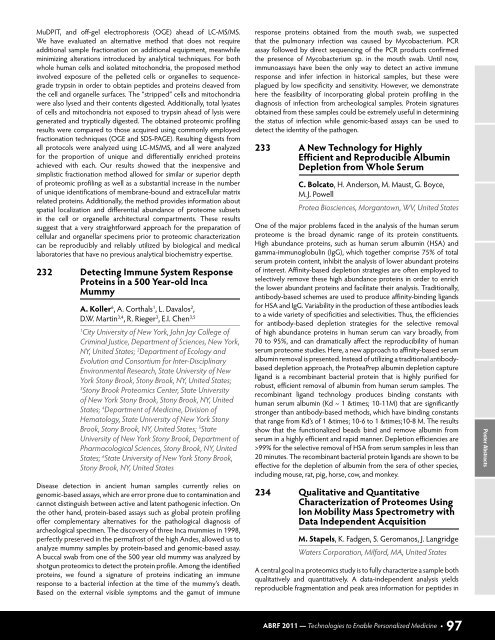Conference Program - ABRF 2011 - Association of Biomolecular ...
Conference Program - ABRF 2011 - Association of Biomolecular ...
Conference Program - ABRF 2011 - Association of Biomolecular ...
- No tags were found...
Create successful ePaper yourself
Turn your PDF publications into a flip-book with our unique Google optimized e-Paper software.
MuDPIT, and <strong>of</strong>f-gel electrophoresis (OGE) ahead <strong>of</strong> LC-MS/MS.We have evaluated an alternative method that does not requireadditional sample fractionation on additional equipment, meanwhileminimizing alterations introduced by analytical techniques. For bothwhole human cells and isolated mitochondria, the proposed methodinvolved exposure <strong>of</strong> the pelleted cells or organelles to sequencegradetrypsin in order to obtain peptides and proteins cleaved fromthe cell and organelle surfaces. The “stripped” cells and mitochondriawere also lysed and their contents digested. Additionally, total lysates<strong>of</strong> cells and mitochondria not exposed to trypsin ahead <strong>of</strong> lysis weregenerated and tryptically digested. The obtained proteomic pr<strong>of</strong>ilingresults were compared to those acquired using commonly employedfractionation techniques (OGE and SDS-PAGE). Resulting digests fromall protocols were analyzed using LC-MS/MS, and all were analyzedfor the proportion <strong>of</strong> unique and differentially enriched proteinsachieved with each. Our results showed that the inexpensive andsimplistic fractionation method allowed for similar or superior depth<strong>of</strong> proteomic pr<strong>of</strong>iling as well as a substantial increase in the number<strong>of</strong> unique identifications <strong>of</strong> membrane-bound and extracellular matrixrelated proteins. Additionally, the method provides information aboutspatial localization and differential abundance <strong>of</strong> proteome subsetsin the cell or organelle architectural compartments. These resultssuggest that a very straightforward approach for the preparation <strong>of</strong>cellular and organellar specimens prior to proteomic characterizationcan be reproducibly and reliably utilized by biological and medicallaboratories that have no previous analytical biochemistry expertise.232 Detecting Immune System ResponseProteins in a 500 Year-old IncaMummyA. Koller 6 , A. Corthals 1 , L. Davalos 2 ,D.W. Martin 3,4 , R. Rieger 3 , E.I. Chen 3,51City University <strong>of</strong> New York, John Jay College <strong>of</strong>Criminal Justice, Department <strong>of</strong> Sciences, New York,NY, United States; 2 Department <strong>of</strong> Ecology andEvolution and Consortium for Inter-DisciplinaryEnvironmental Research, State University <strong>of</strong> NewYork Stony Brook, Stony Brook, NY, United States;3Stony Brook Proteomics Center, State University<strong>of</strong> New York Stony Brook, Stony Brook, NY, UnitedStates; 4 Department <strong>of</strong> Medicine, Division <strong>of</strong>Hematology, State University <strong>of</strong> New York StonyBrook, Stony Brook, NY, United States; 5 StateUniversity <strong>of</strong> New York Stony Brook, Department <strong>of</strong>Pharmacological Sciences, Stony Brook, NY, UnitedStates; 6 State University <strong>of</strong> New York Stony Brook,Stony Brook, NY, United StatesDisease detection in ancient human samples currently relies ongenomic-based assays, which are error prone due to contamination andcannot distinguish between active and latent pathogenic infection. Onthe other hand, protein-based assays such as global protein pr<strong>of</strong>iling<strong>of</strong>fer complementary alternatives for the pathological diagnosis <strong>of</strong>archeological specimen. The discovery <strong>of</strong> three Inca mummies in 1998,perfectly preserved in the permafrost <strong>of</strong> the high Andes, allowed us toanalyze mummy samples by protein-based and genomic-based assay.A buccal swab from one <strong>of</strong> the 500 year old mummy was analyzed byshotgun proteomics to detect the protein pr<strong>of</strong>ile. Among the identifiedproteins, we found a signature <strong>of</strong> proteins indicating an immuneresponse to a bacterial infection at the time <strong>of</strong> the mummy’s death.Based on the external visible symptoms and the gamut <strong>of</strong> immuneresponse proteins obtained from the mouth swab, we suspectedthat the pulmonary infection was caused by Mycobacterium. PCRassay followed by direct sequencing <strong>of</strong> the PCR products confirmedthe presence <strong>of</strong> Mycobacterium sp. in the mouth swab. Until now,immunoassays have been the only way to detect an active immuneresponse and infer infection in historical samples, but these wereplagued by low specificity and sensitivity. However, we demonstratehere the feasibility <strong>of</strong> incorporating global protein pr<strong>of</strong>iling in thediagnosis <strong>of</strong> infection from archeological samples. Protein signaturesobtained from these samples could be extremely useful in determiningthe status <strong>of</strong> infection while genomic-based assays can be used todetect the identity <strong>of</strong> the pathogen.233 A New Technology for HighlyEfficient and Reproducible AlbuminDepletion from Whole SerumC. Bolcato, H. Anderson, M. Maust, G. Boyce,M.J. PowellProtea Biosciences, Morgantown, WV, United StatesOne <strong>of</strong> the major problems faced in the analysis <strong>of</strong> the human serumproteome is the broad dynamic range <strong>of</strong> its protein constituents.High abundance proteins, such as human serum albumin (HSA) andgamma-immunoglobulin (IgG), which together comprise 75% <strong>of</strong> totalserum protein content, inhibit the analysis <strong>of</strong> lower abundant proteins<strong>of</strong> interest. Affinity-based depletion strategies are <strong>of</strong>ten employed toselectively remove these high abundance proteins in order to enrichthe lower abundant proteins and facilitate their analysis. Traditionally,antibody-based schemes are used to produce affinity-binding ligandsfor HSA and IgG. Variability in the production <strong>of</strong> these antibodies leadsto a wide variety <strong>of</strong> specificities and selectivities. Thus, the efficienciesfor antibody-based depletion strategies for the selective removal<strong>of</strong> high abundance proteins in human serum can vary broadly, from70 to 95%, and can dramatically affect the reproducibility <strong>of</strong> humanserum proteome studies. Here, a new approach to affinity-based serumalbumin removal is presented. Instead <strong>of</strong> utilizing a traditional antibodybaseddepletion approach, the ProteaPrep albumin depletion captureligand is a recombinant bacterial protein that is highly purified forrobust, efficient removal <strong>of</strong> albumin from human serum samples. Therecombinant ligand technology produces binding constants withhuman serum albumin (Kd ~ 1 × 10-11M) that are significantlystronger than antibody-based methods, which have binding constantsthat range from Kd’s <strong>of</strong> 1 × 10-6 to 1 ×10-8 M. The resultsshow that the functionalized beads bind and remove albumin fromserum in a highly efficient and rapid manner. Depletion efficiencies are>99% for the selective removal <strong>of</strong> HSA from serum samples in less than20 minutes. The recombinant bacterial protein ligands are shown to beeffective for the depletion <strong>of</strong> albumin from the sera <strong>of</strong> other species,including mouse, rat, pig, horse, cow, and monkey.234 Qualitative and QuantitativeCharacterization <strong>of</strong> Proteomes UsingIon Mobility Mass Spectrometry withData Independent AcquisitionM. Stapels, K. Fadgen, S. Geromanos, J. LangridgeWaters Corporation, Milford, MA, United StatesA central goal in a proteomics study is to fully characterize a sample bothqualitatively and quantitatively. A data-independent analysis yieldsreproducible fragmentation and peak area information for peptides inPoster Abstracts<strong>ABRF</strong> <strong>2011</strong> — Technologies to Enable Personalized Medicine • 97


